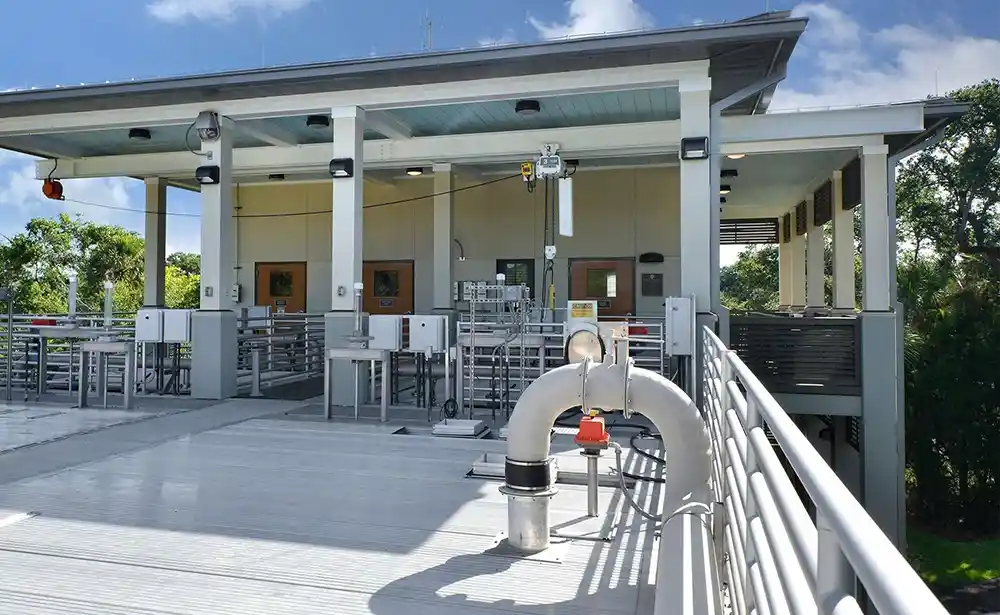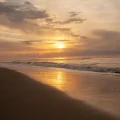
The high quality of living and lifestyle on Isle of Palms is about to be improved even further.
When the island’s new $26.2 million wastewater treatment plant begins operations in January 2024, it will not only represent a state-of-the-art facility to benefit all residents for many decades, but will mark a big step forward in the entire community’s livability.
“The project is Forest Trails Wastewater Treatment Plant Consolidation,” said Chris Jordan, general manager of Isle of Palms Water & Sewer Commission. “And it is built to last for 50-70 years, and is definitely better than what we’re replacing.”
The island is presently served by two existing wastewater treatment plants: the Forest Trails and the Wild Dunes facilities. Forest Trails was replaced with a cast-in-place concrete structure and improved treatment process in 2014. Wild Dunes, in operation since the 1970s, requires continuous maintenance and needs to be replaced, which is part of the reason for the consolidation.
“Together these two plants have served opposite sides of the island,” Jordan said. “The new consolidated plant will serve the entire island with more capacity and room for expansion.”
For example, the new plant alone can treat 1.4 million gallons of effluent per day — approximately the same as the two existing plants combined — enough to serve all 4,300-plus residents.
Designed for future island growth and needs, the plant can be expanded to handle 2.7 million gallons per day, plus room for adding additional equipment as necessary. “It utilizes what’s known as Membrane Bioreactor: high-level wastewater treatment technology which produces re-use quality effluent,” explained Jordan. “And we will not have to build any additional tanks— only add additional membranes and equipment.”
The new plant, designed by Thomas & Hutton Engineering Services in Mount Pleasant, was planned in part with respect to the island’s limited space for growth. Almost all available space on IOP is built out, but the number of island visitors routinely surpasses the number of residents — often reaching as high as 12,000-20,000 during the height of the summer tourist season.
“This new plant is designed to handle that kind of capacity,” Jordan said. “And the consolidation is a complete system consisting of pumps, motors, piping with associated valves, wet well, power supply and an alarm system.”
The new plant, one of IOP’s capital projects, was almost 10 years in the making, and involved two phases. Phase I was completed in 2014 with the replacement of Forest Trails Wastewater Treatment Plant. The consolidation, once finished in March 2024, will complete Phase II, more than two years after construction began.
“This is a high-level tertiary (third stage) treatment plant,” Jordan said. “The effluent is a lot better for the environment, and since the structure is made of concrete instead of steel, it won’t corrode as readily as the facilities we’re replacing.”
Ultraviolet light will be utilized to disinfect treated effluent to kill or inactivate microorganisms in the wastewater. And the new plant will have both a primary screen opening and a smaller, finer screen to remove additional material.
“The new facility is also fortified and flood-proofed to withstand hurricanes and storm surge,” added Jordan.
And a major long-term objective for the new plant is to eventually serve all remaining unsewered areas on the island within eight years. In that time, Jordan said he and other planners expect the new plant to eliminate the need for septic tanks, which currently serve approximately a quarter of all island residents.
“The whole septic/gravity sewer is a pretty hot topic right now,” Jordan said. “There are approximately 1,175 septic tanks on the IOP. If an island property served by septic is a rental, its system could potentially become overloaded with a house full of people. But gravity sewer that goes to a collection system and is treated at a wastewater treatment plant is very reliable.
Of course, in addition to being more efficient and environmentally safe, the new plant will, in its own way, help to keep Isle of Palms the kind of resort and vacation spot that residents and visitors alike have come to enjoy for many generations.
“And this new plant will certainly do its part in keeping the island worry-free from sewer and sewage problems,” Jordan said.
By L. C. Leach III




Leave a Reply